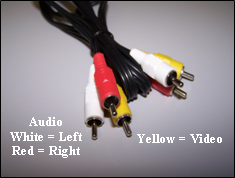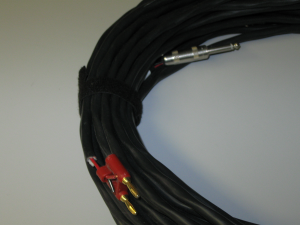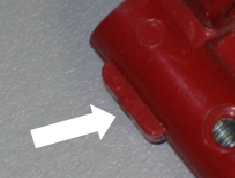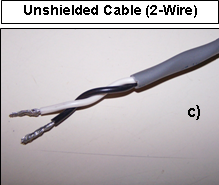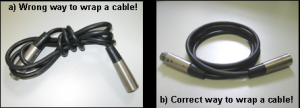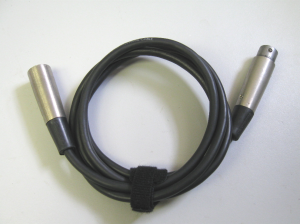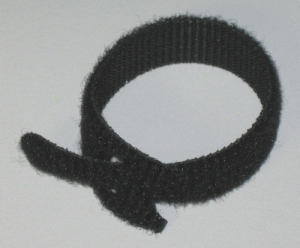Basics of Audio Cables
This basics of audio cables section will focus on the basic audio cables used by musicians, unshielded vs. shielded cable types (and which type is used for which application), and how to properly wrap audio cables.
Below are just a handful of audio cables that Musicians may come across.
Guitar / Bass Cables
Uses two ¼” mono connectors (Unbalanced connection). You will see some of these cables use right angle – ¼” connectors on one end that plug into the guitar side.
Microphone Cables
Uses a Male XLR and a Female XLR connectors (balanced connection). This cable is also used as a “patch” cable in PA systems.
¼” Stereo (TRS)
Uses two ¼” TRS Stereo connectors (balanced connection). This cable is mainly used as a patch cable in PA systems.
¼” Stereo (TRS) to Male XLR
Uses a ¼” TRS Stereo and a Male XLR connector (balanced connection) – Is mainly used as a patch cable in PA systems.
RCA Cable
Uses two RCA connectors for each cable (unbalanced connections). Mostly used with CD / DVD player hookup, and video applications.
1/4 to 1/4 Speaker Cable
Basically two ¼” mono connectors used with a “twisted” pair wire. Used for speaker hookup, monitor speaker hookup, etc. This type of cable is not as popular as it once was – it was found that plugging in a ¼” connector to an amplifier would temporarily “short” the input (and in some situations would cause damage to the amplifier).
 |
CHECK OUT OUR NEW “TECHNICAL” PUBLICATIONS NOW! |
 |
Banana to 1/4″
The banana plug is also used for speaker / amplifier connections, they are very easy to install on the end of a cable. There is a small tab on the banana that indicates the common ( – ) connection).
The great thing about banana connectors is that you can just plug in another speaker if you need to. Obviously you can’t plug in more than two speakers or you may load down the amplifier.
Types of Cable
Shielded / Unshielded – What’s the Difference?
Shielded cables are mainly used for Guitar, Bass Guitar, Mixers, and Microphones (which all have outputs with very low power and are very susceptible to noise and interference). The foil and shield wire are there to protect these low power signals (pictures “a and b”). Unshielded cables are mainly used for high-power (amplifier outputs, speakers). The wires inside the jacket are “twisted” (wound around each other – see picture “c”) for the purpose of canceling out EMI (electromagnetic interference) caused by external sources. Noise and interference is at a very low level so it gets “buried” under the higher output of the amplifier (basically noise that jumps on a high power speaker line will not be heard).
Print out this Handout showing a diagram of Balanced / Unbalanced connections (it will help you understand the Basics of Audio Cables information better).
Balanced / Unbalanced Connections Diagram – CLICK HERE!
a) 3-Wire Shielded Cables have 3 wires (2 wires carry the signal, and 1 wire for the shield). There is also a foil shield around the wires to help protect from EMI (electromagnetic interference), static, and noise spikes. *Used for Balanced connections (microphone cables, patch cables, etc.), which are considered low voltage signals.
b) 2-Wire Shielded Cables have 2 wires (1 wire carries the signal, and 1 wire is used for the shield). Usually the shield wire is wrapped around the center cable (the signal carrier). Used for Guitar / Bass guitar cables, RCA type cables.
* Used for “Unbalanced” Connections, low voltage signals.
c) 2-Wire Unshielded Cables have 2 wires (both wires are signal carriers). These cables are also called “twisted pair” cables (notice that the wires are twisted inside the cable jacket). Used for speaker cables, and considered high voltage (not high voltage as applied to electrical power in a wall outlet, but rather high voltage as applied to amplifier output signals). Balanced and / or Unbalanced does note apply to the high power amplifier output signals that the speaker wires carry.
Wrapping Cables
Once you are finished with your cables you need to wrap them correctly. Wrap the cable (as shown below in example b). Never wrap a cable as shown in example a, example b is the acceptable and preferred cable wrapping.
How to wrap an Audio Cable – Video Clip – Click Here!
Never wrap any audio cables as shown in a) – this could bend the wire strands inside the cables and eventually the cable will fail over time. The correct way is shown in b), and example c) shows a neatly wrapped cable with a “Velcro” cable tie around it (the preferred cable tie to use).
Conclusion
Now that you’ve read the Basics of Audio Cables you can see that there’s a lot more to audio cables than just plugging them in to something. You should now understand that you cannot use speaker type wire as a guitar cable. Or use a guitar cable as a speaker wire (it may appear to work at first, but it can cause signal degradation or even damage to equipment). Think about it – why do they make so many different cables? Why hasn’t that “one cable fits all” been invented yet? Maybe someday? But for now, its best that you understand the different cables and what they are used for. Make sure that you use the proper cable for its intended use. That way, you will get the best reliability that you can get (in addition to a higher quality sound). Many of the audio gear manufacturers are starting to use Cat-6 twisted pair cable as audio patch cables. As they work just as well as shielded cabling in some applications.

BASIC AUDIO TEST EQUIPMENT INFO HERE!




